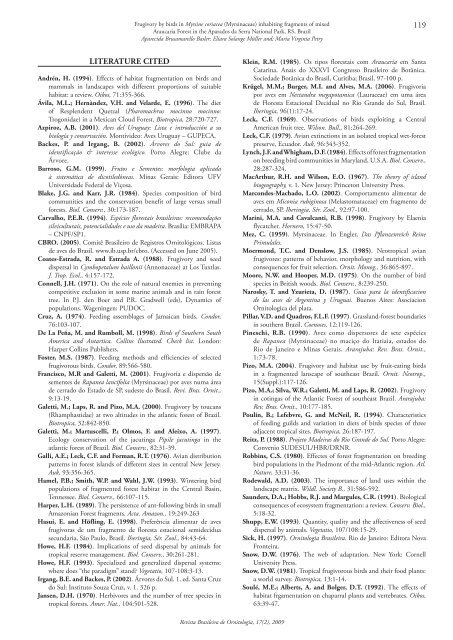art01 - omena júnior.indd - Sociedade Brasileira de Ornitologia
art01 - omena júnior.indd - Sociedade Brasileira de Ornitologia
art01 - omena júnior.indd - Sociedade Brasileira de Ornitologia
- No tags were found...
Create successful ePaper yourself
Turn your PDF publications into a flip-book with our unique Google optimized e-Paper software.
Frugivory by birds in Myrsine coriacea (Myrsinaceae) inhabiting fragments of mixedAraucaria Forest in the Aparados da Serra National Park, RS, BrazilAparecida Brusamarello Basler; Eliara Solange Müller and; Maria Virginia Petry119LitERAtuRE CitedAndrén, H. (1994). Effects of habitat fragmentation on birds andmammals in landscapes with different proportions of suitablehabitat: a review. Oikos, 71:355‐366.Ávila, M.L.; Hernàn<strong>de</strong>z, V.H. and Velar<strong>de</strong>, E. (1996). The dietof Resplen<strong>de</strong>nt Quetzal (Pharomachrus mocinno mocinno:Trogonidae) in a Mexican Cloud Forest. Biotropica, 28:720‐727.Azpiroz, A.B. (2001). Aves <strong>de</strong>l Uruguay: Lista e introducción a subiología y conservación. Montivi<strong>de</strong>o: Aves Uruguay – GUPECA.Backes, P. and Irgang, B. (2002). Árvores do Sul: guia <strong>de</strong>i<strong>de</strong>ntificação & interesse ecológico. Porto Alegre: Clube daÁrvore.Barroso, G.M. (1999). Frutos e Sementes: morfologia aplicadaà sistemática <strong>de</strong> dicotiledôneas. Minas Gerais: Editora UFVUniversida<strong>de</strong> Fe<strong>de</strong>ral <strong>de</strong> Viçosa.Blake, J.G. and Karr, J.R. (1984). Species composition of birdcommunities and the conservation benefit of large versus smallforests. Biol. Conserv., 30:173‐187.Carvalho, P.E.R. (1994). Espécies florestais brasileiras: recomendaçõessilviculturais, potencialida<strong>de</strong>s e uso da ma<strong>de</strong>ira. Brasília: EMBRAPA– CNPF/SP1.CBRO. (2005). Comitê Brasileiro <strong>de</strong> Registros Ornitológicos. Listas<strong>de</strong> aves do Brasil. www.ib.usp.br/cbro. (Accessed on June 2005).Coates-Estrada, R. and Estrada A. (1988). Frugivory and seeddispersal in Cymbopetalum baillonii (Annonaceae) at Los Tuxtlas.J. Trop. Ecol., 4:157‐172.Connell, J.H. (1971). On the role of natural enemies in preventingcompetitive exclusion in some marine animals and in rain foresttree. In P.J. <strong>de</strong>n Boer and P.R. Gradwell (eds), Dynamics ofpopulations. Wageningen: PUDOC.Cruz, A. (1974). Feeding assemblages of Jamaican birds. Condor,76:103‐107.De La Peña, M. and Rumboll, M. (1998). Birds of Southern SouthAmerica and Antartica. Collins Ilustrated. Check list. London:Harper Collins Publishers.Foster, M.S. (1987). Feeding methods and efficiencies of selectedfrugivorous birds. Condor, 89:566‐580.Francisco, M.R and Galetti, M. (2001). Frugivoria e dispersão <strong>de</strong>sementes <strong>de</strong> Rapanea lancifolia (Myrsinaceae) por aves numa área<strong>de</strong> cerrado do Estado <strong>de</strong> SP, su<strong>de</strong>ste do Brasil. Revi. Bras. Ornit.,9:13‐19.Galetti, M.; Laps, R. and Pizo, M.A. (2000). Frugivory by toucans(Rhamphastidae) at two altitu<strong>de</strong>s in the atlantic forest of Brazil.Biotropica, 32:842‐850.Galetti, M.; Martuscelli, P.; Olmos, F. and Aleixo, A. (1997).Ecology conservation of the jacutinga Pipile jacutinga in theatlantic forest of Brazil. Biol. Conserv., 82:31‐39.Galli, A.E.; Leck, C.F. and Forman, R.T. (1976). Avian distributionpatterns in forest islands of different sizes in central New Jersey.Auk, 93:356‐365.Hamel, P.B.; Smith, W.P. and Wahl, J.W. (1993). Wintering birdpopulations of fragmented forest habitat in the Central Basin,Tennessee. Biol. Conserv., 66:107‐115.Harper, L.H. (1989). The persistence of ant-following birds in smallAmazonian Forest fragments. Acta. Amazon., 19:249‐263Hasui, E. and Höfling, E. (1998). Preferência alimentar <strong>de</strong> avesfrugívoras <strong>de</strong> um fragmento <strong>de</strong> floresta estacional semi<strong>de</strong>cíduasecundaria, São Paulo, Brasil. Iheringia, Sér. Zool., 84:43‐64.Howe, H.F. (1984). Implications of seed dispersal by animals fortropical reserve management. Biol. Conserv., 30:261‐281.Howe, H.F. (1993). Specialized and generalized dispersal systems:where does “the paradigm” stand? Vegetatio, 107‐108:3‐13.Irgang, B.E. and Backes, P. (2002). Árvores do Sul. 1. ed. Santa Cruzdo Sul: Instituto Souza Cruz, v. 1. 326 p.Jansen, D.H. (1970). Herbivores and the number of tree species intropical forests. Amer. Nat., 104:501‐528.Klein, R.M. (1985). Os tipos florestais com Araucaria em SantaCatarina. Anais do XXXVI Congresso Brasileiro <strong>de</strong> Botânica.<strong>Socieda<strong>de</strong></strong> Botânica do Brasil, Curitiba; Brasil, 97‐100 p.Krügel, M.M.; Burger, M.I. and Alves, M.A. (2006). Frugivoriapor aves em Nectandra megapotamica (Lauraceae) em uma área<strong>de</strong> Floresta Estacional Decidual no Rio Gran<strong>de</strong> do Sul, Brasil.Iheringia, 96(1):17‐24.Leck, C.F. (1969). Observations of birds exploiting a CentralAmerican fruit tree. Wilson. Bull., 81:264‐269.Leck, C.F. (1979). Avian extinctions in an isolated tropical wet-forestpreserve, Ecuador. Auk, 96:343‐352.Lynch, J.F. and Whigham, D.F. (1984). Effects of forest fragmentationon breeding bird communities in Maryland, U.S.A. Biol. Conserv.,28:287‐324.MacArthur, R.H. and Wilson, E.O. (1967). The theory of islandbiogeography, v. 1. New Jersey: Princeton University Press.Marcon<strong>de</strong>s-Machado, L.O. (2002). Comportamento alimentar <strong>de</strong>aves em Miconia rubiginosa (Melastomataceae) em fragmento <strong>de</strong>cerrado, SP. Iheringia, Sér. Zool., 92:97‐100.Marini, M.A. and Cavalcanti, R.B. (1998). Frugivory by Elaeniaflycatcher. Hornero, 15:47‐50.Mez, C. (1959). Myrsinaceae. In Engler, Das Pflanzenreich ReinePrimulales.Moermond, T.C. and Denslow, J.S. (1985). Neotropical avianfrugivores: patterns of behavior, morphology and nutrition, withconsequences for fruit selection. Ornit. Monog., 36:865‐897.Moore, N.W. and Hooper, M.D. (1975). On the number of birdspecies in British woods. Biol. Conserv., 8:239‐250.Narosky, T. and Yzurieta, D. (1987). Guia para la i<strong>de</strong>ntificacion<strong>de</strong> las aves <strong>de</strong> Argentina y Uruguai. Buenos Aires: AsociacionOrnitologica <strong>de</strong>l plata.Pillar, V.D. and Quadros, F.L.F. (1997). Grassland-forest boundariesin southern Brazil. Coenoses, 12:119‐126.Pineschi, R.B. (1990). Aves como dispersores <strong>de</strong> sete espécies<strong>de</strong> Rapanea (Myrsinaceae) no maciço do Itatiaia, estados doRio <strong>de</strong> Janeiro e Minas Gerais. Ararajuba: Rev. Bras. Ornit.,1:73‐78.Pizo, M.A. (2004). Frugivory and habitat use by fruit-eating birdsin a fragmented lanscape of southeast Brazil. Ornit. Neotrop.,15(Suppl.):117‐126.Pizo, M.A.; Silva, W.R.; Galetti, M. and Laps, R. (2002). Frugivoryin cotingas of the Atlantic Forest of southeast Brazil. Ararajuba:Rev. Bras. Ornit., 10:177‐185.Poulin, B.; Lefebvre, G. and McNeil, R. (1994). Characteristicsof feeding guilds and variation in diets of birds species of threeadjacent tropical sites. Biotropica, 26:187‐197.Reitz, P. (1988). Projeto Ma<strong>de</strong>iras do Rio Gran<strong>de</strong> do Sul. Porto Alegre:Convenio SUDESUL/HBR/DRNR.Robbins, C.S. (1980). Effectes of forest fragmentation on breedingbird populations in the Piedmont of the mid-Atlantic region. Atl.Nature, 33:31‐36.Ro<strong>de</strong>wald, A.D. (2003). The importance of land uses within thelandscape matrix. Wildl. Society B., 31:586‐592.Saun<strong>de</strong>rs, D.A.; Hobbs, R.J. and Margules, C.R. (1991). Biologicalconsequences of ecosystem fragmentation: a review. Conserv. Biol.,5:18‐32.Shupp, E.W. (1993). Quantity, quality and the affectiveness of seeddispersal by animals. Vegetatio, 107/108:15‐29.Sick, H. (1997). <strong>Ornitologia</strong> <strong>Brasileira</strong>. Rio <strong>de</strong> Janeiro: Editora NovaFronteira.Snow, D.W. (1976). The web of adaptation. New York: CornellUniversity Press.Snow, D.W. (1981). Tropical frugivorous birds and their food plants:a world survey. Biotropica, 13:1‐14.Soulé, M.E.; Alberts, A. and Bolger, D.T. (1992). The effects ofhabitat frgamentation on chaparral plants and vertebrates. Oikos,63:39‐47.Revista <strong>Brasileira</strong> <strong>de</strong> <strong>Ornitologia</strong>, 17(2), 2009
















